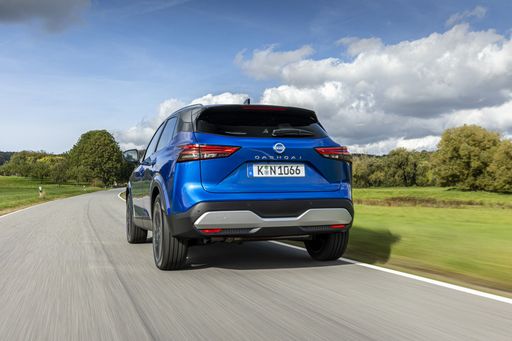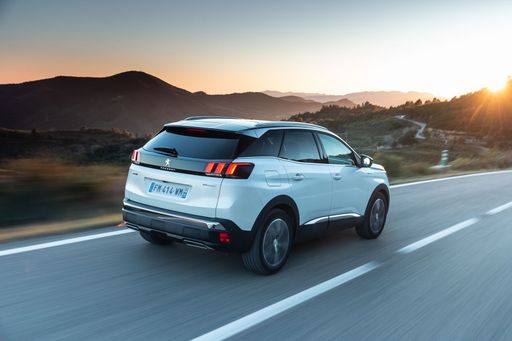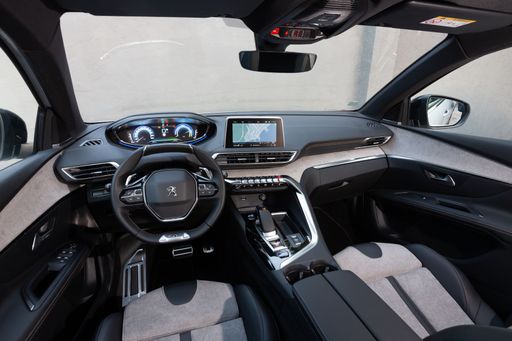In the competitive world of compact SUVs, the Nissan Qashqai and Peugeot 3008 have emerged as popular contenders, each offering a unique blend of style, technology, and performance. This article delves into the technical specifications, innovative features, and overall driving experience of both vehicles to help you determine which one might be the right fit for you.
Nissan Qashqai vs Peugeot 3008 – Performance, range & efficiency compared
Both models have their strengths – but which one suits you more?
Compare performance, efficiency, price and space directly: Nissan Qashqai or Peugeot 3008?
Design and Dimensions
Both the Nissan Qashqai and Peugeot 3008 showcase modern, attractive designs that cater to the taste of contemporary SUV buyers. The Qashqai measures 4425 mm in length, 1835 mm in width, and stands 1625 mm high. In contrast, the 3008 is slightly larger, with dimensions of 4542 mm in length, 1895 mm in width, and 1641 mm in height. This size difference offers an edge to the Peugeot when it comes to cabin space and comfort.
Powertrains and Performance
The Nissan Qashqai offers a range of engine choices, including petrol MHEV and full hybrid configurations, boasting power outputs ranging from 140 HP to 190 HP. With a variety of transmission options such as manual, automatic CVT, and reduction gearbox, it caters to various driving preferences. The Qashqai achieves remarkable fuel consumption, with figures reaching as low as 5.1 L/100 km.
On the other hand, the Peugeot 3008 introduces an impressive lineup that includes petrol MHEV, plug-in hybrid, and fully electric options, making it a versatile choice for eco-conscious drivers. Power outputs range from 136 HP to a robust 231 HP. The 3008’s cutting-edge electric range reaches up to 698 km with its largest battery, allowing for extended journeys without the need for frequent charging.
Driving Dynamics
When it comes to acceleration, the Qashqai impressively goes from 0-100 km/h in as little as 7.9 seconds, while the 3008 matches this with acceleration figures ranging from 8.4 to 10.2 seconds depending on the variant. Both models offer front-wheel drive, with the Qashqai additionally providing all-wheel drive for those who seek enhanced traction and stability.
Interior and Technology
Inside the cabin, the Qashqai presents a driver-focused environment with spacious seating for five and a trunk capacity of 504 L. The interior styling is modern, and the infotainment system includes a suite of connectivity options that cater to tech-savvy drivers.
The Peugeot 3008, however, takes the interior experience a notch higher with its 'i-Cockpit' design that features a small steering wheel and high-mounted instrument panel for improved visibility. The 3008 also offers a slightly larger trunk capacity of 520 L, allowing for more storage space. Both vehicles are equipped with advanced safety features, but Peugeot's offering has consistently received high ratings in safety assessments.
Innovation and Efficiency
One of the standout features of the Qashqai is its mild hybrid technology, which helps to enhance fuel efficiency and reduce emissions. The Qashqai's CO2 emissions range from 116 g/km to 154 g/km, placing it in efficiency classes E and D.
The Peugeot 3008 shines in this area as well, with CO2 emissions as low as 0 g/km for the electric variant, making it an attractive option for environmentally conscious consumers. Its efficiency classes range from A to D, highlighting its commitment to sustainability.
Conclusion: Which One to Choose?
Both the Nissan Qashqai and Peugeot 3008 have a lot to offer in the compact SUV market. If you prefer a sportier drive with robust hybrid options, the Qashqai might be your choice. However, if you seek advanced technology, a touch of luxury, and diverse powertrain offerings—including fully electric—then the Peugeot 3008 could be the better fit.
Ultimately, your decision may depend on personal preferences regarding driving dynamics, interior features, and environmental impact. Test-driving both vehicles is the best way to experience their differences firsthand.
Here’s where it gets real: The technical differences in detail
Costs and Efficiency:
Price and efficiency are key factors when choosing a car – and this is often where the real differences emerge.
Nissan Qashqai has a to a small extent advantage in terms of price – it starts at 29400 £, while the Peugeot 3008 costs 35100 £. That’s a price difference of around 5751 £.
Fuel consumption also shows a difference: Peugeot 3008 manages with 0.90 L and is therefore significantly more efficient than the Nissan Qashqai with 5.10 L. The difference is about 4.20 L per 100 km.
Engine and Performance:
Under the bonnet, it becomes clear which model is tuned for sportiness and which one takes the lead when you hit the accelerator.
When it comes to engine power, the Peugeot 3008 has a significantly edge – offering 325 HP compared to 190 HP. That’s roughly 135 HP more horsepower.
In acceleration from 0 to 100 km/h, the Peugeot 3008 is clearly perceptible quicker – completing the sprint in 6 s, while the Nissan Qashqai takes 7.90 s. That’s about 1.90 s faster.
In terms of top speed, the Peugeot 3008 performs hardly perceptible better – reaching 220 km/h, while the Nissan Qashqai tops out at 206 km/h. The difference is around 14 km/h.
There’s also a difference in torque: Peugeot 3008 pulls noticeable stronger with 511 Nm compared to 330 Nm. That’s about 181 Nm difference.
Space and Everyday Use:
Cabin size, boot volume and payload all play a role in everyday practicality. Here, comfort and flexibility make the difference.
Both vehicles offer seating for 5 people.
In curb weight, Nissan Qashqai is a bit lighter – 1420 kg compared to 1648 kg. The difference is around 228 kg.
In terms of boot space, the Peugeot 3008 offers slight more room – 520 L compared to 504 L. That’s a difference of about 16 L.
In maximum load capacity, the Peugeot 3008 performs barely noticeable better – up to 1480 L, which is about 33 L more than the Nissan Qashqai.
When it comes to payload, Nissan Qashqai a bit takes the win – 520 kg compared to 467 kg. That’s a difference of about 53 kg.
Who comes out on top?
Overall, the Peugeot 3008 shows itself to be leaves the rival little chance and secures the title of DriveDuel Champion.
It convinces with the more balanced overall package and proves to be the more versatile choice for everyday use.
 @ Peugeot / Stellantis Media
@ Peugeot / Stellantis Media
Peugeot 3008
Nissan Qashqai
The Nissan Qashqai blends practical, family-friendly packaging with SUV styling that refuses to shout, making it a sensible and dependable choice for everyday life. It’s comfortable to live with, economical on the road, and neatly equipped enough to feel modern without ever feeling precious — perfect if you want crossover versatility without the drama.
details @ Nissan Motor Corporation
@ Nissan Motor Corporation
 @ Nissan Motor Corporation
@ Nissan Motor Corporation
 @ Nissan Motor Corporation
@ Nissan Motor Corporation
 @ Nissan Motor Corporation
@ Nissan Motor Corporation
 @ Nissan Motor Corporation
@ Nissan Motor Corporation
Peugeot 3008
The Peugeot 3008 blends bold French styling with a surprisingly grown-up interior that makes even dull commutes feel a little bit special. Practical enough for family life yet lively to drive, it’s a clever all‑rounder that stands out from the crossover crowd without shouting for attention.
details @ Peugeot / Stellantis Media
@ Peugeot / Stellantis Media
 @ Peugeot / Stellantis Media
@ Peugeot / Stellantis Media
 @ Peugeot / Stellantis Media
@ Peugeot / Stellantis Media
 @ Peugeot / Stellantis Media
@ Peugeot / Stellantis Media
 @ Nissan Motor Corporation
@ Nissan Motor Corporation
|
 @ Peugeot / Stellantis Media
@ Peugeot / Stellantis Media
|
|
|
|
Costs and Consumption |
|
|---|---|
|
Price
29400 - 42500 £
|
Price
35100 - 51400 £
|
|
Consumption L/100km
5.1 - 6.8 L
|
Consumption L/100km
0.9 - 5.4 L
|
|
Consumption kWh/100km
-
|
Consumption kWh/100km
16.9 - 17.8 kWh
|
|
Electric Range
-
|
Electric Range
85 - 698 km
|
|
Battery Capacity
-
|
Battery Capacity
0.4 - 96.9 kWh
|
|
co2
116 - 154 g/km
|
co2
0 - 121 g/km
|
|
Fuel tank capacity
55 L
|
Fuel tank capacity
55 L
|
Dimensions and Body |
|
|---|---|
|
Body Type
SUV
|
Body Type
SUV
|
|
Seats
5
|
Seats
5
|
|
Doors
5
|
Doors
5
|
|
Curb weight
1420 - 1665 kg
|
Curb weight
1648 - 2337 kg
|
|
Trunk capacity
479 - 504 L
|
Trunk capacity
470 - 520 L
|
|
Length
4425 mm
|
Length
4542 mm
|
|
Width
1835 mm
|
Width
1895 mm
|
|
Height
1625 mm
|
Height
1641 mm
|
|
Max trunk capacity
1422 - 1447 L
|
Max trunk capacity
1430 - 1480 L
|
|
Payload
466 - 520 kg
|
Payload
383 - 467 kg
|
Engine and Performance |
|
|---|---|
|
Engine Type
Petrol MHEV, Full Hybrid
|
Engine Type
Plugin Hybrid, Electric, Petrol MHEV
|
|
Transmission
Manuel, Automatic
|
Transmission
Automatic
|
|
Transmission Detail
Manual Gearbox, CVT, Reduction Gearbox
|
Transmission Detail
Dual-Clutch Automatic, Reduction Gearbox
|
|
Drive Type
Front-Wheel Drive, All-Wheel Drive
|
Drive Type
Front-Wheel Drive, All-Wheel Drive
|
|
Power HP
140 - 190 HP
|
Power HP
145 - 325 HP
|
|
Acceleration 0-100km/h
7.9 - 10.2 s
|
Acceleration 0-100km/h
6 - 10.2 s
|
|
Max Speed
170 - 206 km/h
|
Max Speed
170 - 220 km/h
|
|
Torque
240 - 330 Nm
|
Torque
230 - 511 Nm
|
|
Number of Cylinders
3 - 4
|
Number of Cylinders
3 - 4
|
|
Power kW
103 - 140 kW
|
Power kW
107 - 239 kW
|
|
Engine capacity
1332 - 1497 cm3
|
Engine capacity
1199 - 1598 cm3
|
General |
|
|---|---|
|
Model Year
2024
|
Model Year
2024 - 2025
|
|
CO2 Efficiency Class
E, D
|
CO2 Efficiency Class
B, A, D
|
|
Brand
Nissan
|
Brand
Peugeot
|
Is the Nissan Qashqai offered with different drivetrains?
Available configurations include Front-Wheel Drive or All-Wheel Drive.
The prices and data displayed are estimates based on German list prices and may vary by country. This information is not legally binding.
